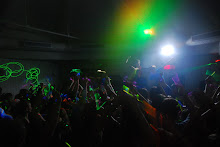Well, I've decided that my first post will be about a great product available from Atomix called Virtual Dj. Virtual Dj is a computer software interface that emulates the controls found on modern day decks. Since I've been been using this program for a little while now to mix mainly house and electro beats, so I figured I would go over some of its features for anyone who is interested.
Getting Started
A free 20 day trial of Virtual Dj is available on theirwebsite. Once you download this, setup is fairly easy for a beginner who is dipping their toes into the world of mixing and doesn't have to worry about hardware interfaces. Just start up the program, and select "internal mixer interface".
You should have something like the picture to the right, perhaps without the Buckethead background.
Key Features and Implementation

You will notice that VDJ features two tracks, on which you can drag and drop your music after you find it using the navigator. The level at which this tracks is put out to the speakers is controlled by the Crossfader, which is the the bar in the middle which travels from side to side. While Vdj does offer an automix function, it is much more benificial to just jump right in with manual mixing. As you can see, I have 2 songs loaded on the tracks, and I am playing the track on the left, because my crossf ade is all the way over there. I'm about to make the transition to the next song, BUT, the songs are different speeds. OH NO! Thankfully, I can use the handy sync function that is provided with the program, to adjust the speed of the second song to match that of the first, without changing the pitch. *NOTE: do not attempt to adjust the speed of the song by more than 15-20 bpm or so while using the keylock, as this will distort the sound.* I now start the song on the right track, trying my best to line up beat one, which is denoted by the thick bar on the visual interface, on both songs. dont worry too much about gettin it lined up perfect, because we can use that same sync button again to line the beats up perfectly. At this point, it is time for us to start fading into the new track. I usally like to do this about 16 beats before the outro of the first song starts, and then i gradually shift it over into the intro of the new song. You can r eturn the new song back to its original speed by clicking the "0" on the vertical slider, or you can keep it the speed that it is at.
Bonus Features
After you play around with transitions for a little bit (honestly, it will take a couple hours of just transitions until you get a real feel for it) you can start to explore som e of the other possibilites that Virtual DJ offers. VDJ comes with a number of base effects and a couple samples, which will allow you to customize the songs you are playing. After you purchase the product there will be a lot more available for download, but, for now we can just have fun with the limited number that we have. You can access these features using either the drop down menus on the track deck, or by selecting the tab on the lower interface. Whichever way you choose, usage is going to operate almost the same

The only advice I can give in this section is to play around, and get comfortable with these feature, but don't overuse any one thing, I.e. Backspin. You can record your own samples or rip them out of other songs to truly give your mix a one of a kind feel.
Conclusion
Virtual Dj is a great tool for the beginner, because its interface is very easy to understand, and you do not actually need to be able to pick out a beat thanks to the beat visualizer. You may find that, as you progress, you will want to upgrade to a more reputed software interface, so you can use more types of hardware, however, Virtual Dj can handle timecoded records almost as easily as programs like Serato Scratch and Traktor. For the time being, just have some fun, and impress your friends with your crazy mixing skills.






